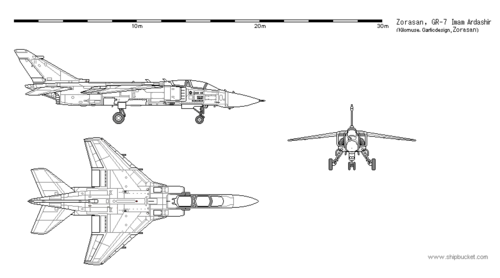SAI GR-7 Imam Ardashir
| SAI G-7 Imam Ardashir | |
|---|---|

| |
| A SAI G-7/B on the tarmac | |
| Role | Attack aircraft |
| National origin | Zorasan |
| Manufacturer | Soltanabad Aeronautic Industries |
| Designer | Soltanabad Aerospace Design Institute |
| First flight | 1970 |
| Introduction | 1975 |
| Status | In service |
| Primary user | |
| Produced | 1974-1990 |
| Number built | 266 |
The SAI GR-7 Imam Ardashir (Pasdani: امام اردشیر گر-۷) is a twin-seat attack aircraft used by the Zorasani Irfanic Revolutionary Army Air Force in the close air support role.
Initially designed as a medium-range interceptor, the final design was radically altered to meet the requirements of a domestically produced fighter-bomber, where the ZIRAAF had historically been lacking. Considerable effort was placed into the design and production of the first domestic supersonic capable turbofan engine, this was ultimately achieved with the inception of the Badyar-1352. The final design also saw a strengthened airframe and more hardpoints, to grant the aircraft a significantly larger payload than originally intended.
The GR-7 has seen extensive operational service, proving highly vauled in the Irvadistan War by the ZIRAAF, but also saw action in the Al-Thawra Rebellion, Al-Hizan Uprising, the Kexri Conflict and the 2003-2004 Amardo-Zorasani Standoff. Despite the purchase of 40 Shengkong JK-10 fighter-bombers in 1999, the GR-7 has remained in service, with significant upgrades to its avionics, engine and fuel tank since its introduction in 1974.
